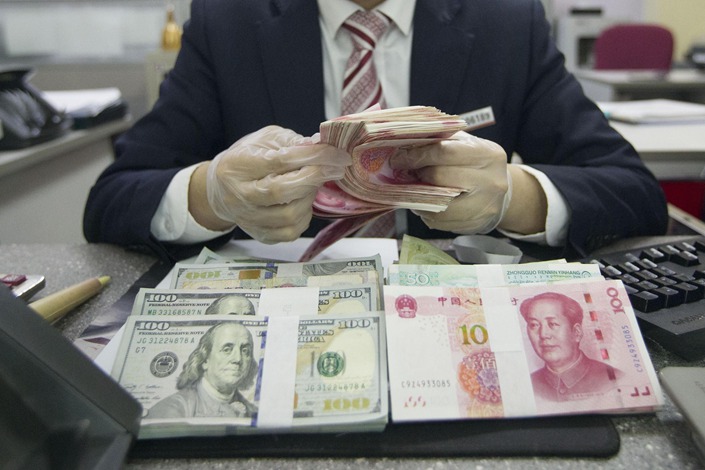
In 2021, the yuan has continued to appreciate against the U.S. dollar, with the exchange rate rising from nearly 7 per dollar at the beginning of the year to around 6.4 now, an increase of about 2%.
The appreciation alone is not significant, but it is exceptional in two aspects. First, the U.S. dollar index has strengthened this year, rising by around 4.5%, which means the Chinese currency has appreciated even more against other major currencies. Second, the Chinese and U.S. economies have diverged significantly this year. The official manufacturing purchasing managers index (PMI) in China has fallen below 50 over the past two months, nearing the lowest level in the past decade, while the recent readings in the U.S. were still as high as 60.
The narrowing of the yield spread between Chinese and U.S. 10-year government bonds and the divergent performances of the two countries’ respective stock markets, to some extent, both reflect the differences in their economic cycles.
What’s behind the rise of the yuan? In my view, it is the exceptionally strong exports. The strength in exports can be largely attributed to the pandemic, which not only led to a bigger surplus for the trade in goods and a subsequent higher demand for foreign exchange settlements, but also reduced the demand for foreign exchange to transact the trade in services, such as overseas tourism and education. Both benefited the yuan exchange rate.
As the impact from the pandemic and overseas stimulus policies wanes, a slowdown in China’s export growth could lead to a decrease in the goods trade surplus. Meanwhile, a rebound in cross-border tourism could result in the rise of the nation’s services trade deficit. Thus, the current account surplus’ support for the yuan could weaken significantly in 2022.
It’s worth noting that the recent growth in China’s export value has been supported to a large extent by rising prices, as the seasonally adjusted quarter-on-quarter growth in export volume turned negative in the third quarter, and the gauge for new export orders under the manufacturing PMI index has been below 50 for six consecutive months.
Currently, industrial production in emerging Asian countries, excluding China, has largely returned to normal long-term trends, suggesting that the pandemic has had a limited impact on supplies in these regions. However, China’s share of global exports has not declined significantly. That is because the pandemic has amplified the strength of China’s industrial chain and export competitiveness, resulting in some demand returning.
As proof of this, direct overseas investment inflows under the current account have reached a record high this year, indicating China’s attractiveness to overseas capital. Therefore, even if the pandemic fully subsides, China’s share of global exports will not fall to pre-pandemic levels, which means the logic supporting long-term yuan strength remains valid.
China’s central bank has been cautious about easing monetary policy, while the U.S. Federal Reserve is hesitant about normalizing its loose monetary policy. So, short-term interest rates in the world’s two largest economies have not been adjusted in a timely manner in response to their economic fundamentals. After deducting core inflation, China’s real interest rates are relatively high, while those in the U.S. are too low, which have also supported the yuan.
A strong yuan has led to tighter monetary conditions, which is unfavorable for an economic recovery. So it is increasingly possible that China’s central bank will guide interest rates downward. Considering that the country’s economy will likely come under pressure from weak domestic and external demand in the future, monetary policy will need to be adjusted to support the economy.
Cutting interest rates will, on the one hand, shrink the China-U.S. interest rate gap and temporarily weaken the yuan exchange rate, and on the other hand, help stabilize social financing and the money supply measured by M1. Therefore, the possibility of lowering interest rates as a means to support the economy is growing.
In the short term, if the Chinese central bank eases monetary policy while the Fed tapers bond purchases, the yuan could face temporary depreciation pressure in 2022. In the long term, it is difficult for China’s central bank to shift its prudential monetary policy stance. China is one of the few major economies that can count on structural reforms in coordination with other policies to support its economy without relying entirely on easing monetary policy. In contrast, the record high outstanding government debt in the U.S. will force the Fed to maintain a relatively loose monetary policy. Therefore, the divergence in monetary policies of the U.S. and China will support a strong yuan in the long term.
Liu Mingxi contributed to this article.
Xu Xiaoqing is director of macro strategy at Zhejiang province-based fund manager DH Fund Management Co. Ltd.
The views and opinions expressed in this opinion section are those of the authors and do not necessarily reflect the editorial positions of Caixin Media.
If you would like to write an opinion for Caixin Global, please send your ideas or finished opinions to our email: opinionen@caixin.com
Contact translator Guo Yingzhe (yingzheguo@caixin.com) and editor Lin Jinbing (jinbinglin@caixin.com)
Get our weekly free Must-Read newsletter.







